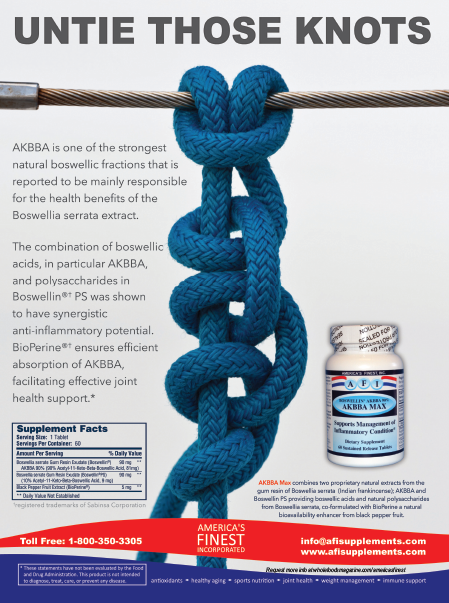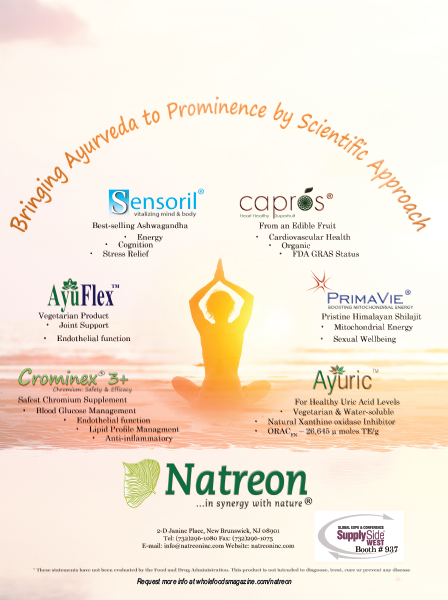Many fitness enthusiasts are looking for a little extra support for their joints, and natural products stores are popular places to get it. Start them off with the basics you’d suggest for any other shopper, like a multivitamin, to cover their bases. Then, talk to them about supplements that support balanced inflammation and a healthy joint structure.
Athletes are used to working their bodies to the limits. But, all that jumping, stretching, twisting and pounding does a number on the joints. “Although their tissues are youthful enough for cells to repair, the mechanical forces and repetitive stress applied to athletes’ tendons, ligaments and cartilage overwhelm the methodical pace of the tissue’s restorative biological processes,” says Herb Joiner-Bey, N.D., medical science consultant at Barlean’s Organic Oils, Ferndale, WA.
Therefore, many fitness enthusiasts are looking for a little extra support for their joints, and natural products stores are popular places to get it. Start them off with the basics you’d suggest for any other shopper, like a multivitamin, to cover their bases. Then, talk to them about supplements that support balanced inflammation and a healthy joint structure.
“If an athlete is not getting proper nutrition and training hard, the joints often suffer,” says Sara J. Pluta Carter, M.S., nutrition educator at Carlson Laboratories, Arlington Heights, IL. “If training continues without proper nourishment micro-tears can begin to occur in the tendons as well as deterioration of the cartilage in the joint. Chronically low levels of important nutrients combined with athletics can lead to conditions like osteoarthritis and tendonitis.”
When shoppers talk about needing joint support, you should have a sense of how selling joint care products for athletes is different from other shoppers. Nena Dockery, technical services manager at Stratum Nutrition, St. Charles, MO, explains that most healthy individuals experience normal wear and tear on the joints as part of life. Over time, osteoarthritis may develop from a slow degradation of the cartilage around the joints. Inflammation in the area is typically secondary, she states.
“The scenario for the athlete is quite different,” says Dockery. “Though athletes can experience stress and trauma directly to the joint, in most cases, injury occurs in the soft tissue surrounding the joint.”
She says injury to the soft tissue spurs the immune system to flood the area with pro-inflammatory agents to isolate the area for healing. Then, anti-inflammatory substances are signaled to take down inflammation and return to homeostasis.
This process is normal. But, when these inflammatory substances stay for weeks or months after the initial injury, problems can arise. “These cytokines disrupt the normal tissue breakdown and building process by inducing the production of cartilage-degrading proteases, eventually damaging the cartilage within the joint,” says Dockery. For this reason, she believes that joint-care products for athletes should support a healthy and balanced inflammatory process—especially immediately following injury.
Adds Timothy Mount, CN, CCMH, director of education for NeoCell Corp., Irvine, CA, “Preventive supplements can strengthen our joint structure to reduce the risk of injury, or if an injury occurs, supplements can increase the rate of recovery dramatically.”
What might help provide this joint support? Mount’s preference is collagen, because “the majority of connective tissue is made of this critical protein.” He offers some numbers to back this up: about 99% of tendons, 86% of ligaments, 60% of cartilage and 36% of bone is made of collagen, he states.
Mount says collagen acts as the structural matrix of the tissues. “Damaged or weak collagen not only causes joint instability, but is also painful and can limit an athlete’s performance,” he explains. For this reason, he believes supplemental collagen is an important tool for athletes since it supports healthy joint structure.
Arica West, director of product development for Creative Bioscience, Salt Lake City, UT, says one branded collagen (BioCell Collagen) was found to protect the connective tissue in the muscles and enhances recovery from intense exercise (1). Eight healthy volunteers took a placebo or the collagen (3 g daily) for six weeks and completed resistance challenges. The collagen had a positive impact on various markers of tissue damage following exercise.
Mount could not agree more that collagen is beneficial for athletes. For post-workout recovery, he believes that collagen is often overlooked, with attention often going to protein drinks, BCAAs, glutamine and carbs. “I contend [collagen] is the most important recovery supplement available,” says Mount.
The reason why, he states, is that the aforementioned post-workout favorites target muscular support or energy recovery. “They put the cart before the horse,” Mount feels. “Muscular growth is important, but not as important as strong connective tissue…Injury prevention with a collagen supplement pays off in the long run because the athlete will spend more time competing and less time in the doctor’s office.”
His company offers a product (NeoCell’s Collagen Sport) that combines whey, BCAAs, glutamine and collagen peptides. But, for those that want targeted joint support (like long-distance runners or those with popping joints), he recommends a formula (NeoCell’s Type 2 Collagen Joint Complex) that offers type-II collagen, which contains glucosamine, chondroitin and hyaluronic acid.
Lara Niemann, marketing director, Americas at GELITA USA, Sergeant Bluff, IA, likes a collegen peptide from her company (FORTIGEL) that she says has data backing for spurring the regeneration of cartilage in the joints. “FORTIGEL stimulates the cartilage cells to increase the production of both collagen and proteoglycans—the two major components that make up almost 90% of cartilage dry mass,” Niemann states.
One study on it involved 147 college athletes with joint problems. For 24 weeks, participants took the branded collagen peptide or a placebo. “Compared with the control group, the students who took collagen peptides showed a significant reduction in exercise-induced pain as well as improved mobility,” says Niemann. “In particular, these positive effects were obvious in participants with knee joint problems brought on by mechanical strain.”
Dockery says natural eggshell membrane (like her company’s NEM brand) is a source of collagen and glycosaminoglycans (GAGs) like chondroitin sulfate and hyaluronic acid (HA). She says that her firm’s branded form (the NEM brand) helps maintain a healthy inflammatory response and supports improved range of motion and comfort in joint tissue.
Mount adds that HA lubricates joints and allows them to absorb some force upon impact: “Synovial fluid, which reduces friction in the joint, is made of HA and water, so any loss of HA will cause excessive wear and tear on the joint.” The shock-absorbing properties of HA is the reason why Mount says HA is especially important to athletes that run and jump “because the meniscus in the knee is easily damaged if the cartilage is not adequately hydrated with HA.”
Actually, when evaluating whether a joint health ingredient is beneficial for athletes, some researchers like to look at this specifically at the knee. Says Paul Dijkstra, president and CEO of InterHealth Nutraceuticals, Benicia, CA, “Knee function and comfort matter for athletes of all types. Maintaining knee joint function supports mobility, increases flexibility and may support the ability to exercise longer and more regularly.”
In agreement is Weiguo Zhang, president and CEO of Synutra Pure, Ltd., Rockville, MD, who states, “Maintenance of knee health and functionality has always been the most prominent objective in joint care for athletes.” He says that the American College of Sports Medicine stated in a recent report that sports injuries can even lead to osteoarthritis of the knees.
So, which supplements have been studied on the knees? Forty-three clinical studies on the effect of chondroitin sulfate on knee pain were reviewed by a group of researchers earlier this year (3), with many focusing on knee osteoarthritis. Chondroitin (alone or with glucosamine) improved knee pain in short-term studies and slightly slowed down the narrowing width of affected cartilage in the knee.
Adds Zhang, “There is not yet enough clinical evidence on chondroitin helping in repairing or restoring cartilage losses directly related to sports injuries, but it is our opinion that longer term and earlier supplementation of chondroitin sulfate among athletes could only help in maintenance of long term knee health, with or without traumatic knee injuries.”
Also studying the effect of nutrients on knee joints, Dijkstra says that one branded collagen from his company (UC-II) has been studied for it affects on joint flexibility as measured by knee extension.
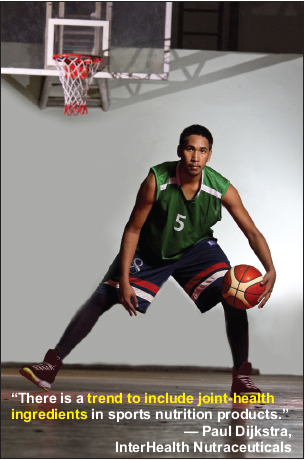
In one study, 55 healthy subjects took 40 mg of UC-II or a placebo. At the 90- and 120-day marks, the supplements group had improved knee extension, could exercise longer without discomfort and recovered faster from joint discomfort following exercise (4). “This data suggests that it may be possible to exercise longer with UC-II before experiencing joint discomfort,” says Dijkstra.
Some athletes may find that antioxidants help keep them in tiptop shape. Says West, “When stress put on the joints exceeds the rate that your body can regenerate, it allows for inflammation to set in.”
Tim Marr, professional triathlete and Nutrex Hawaii’s Oahu sales director, Kailua-Kona, HI, says astaxanthin is one antioxidant that physically active shoppers should have on their radars. While it does not treat injuries or prevent chronic inflammation, compelling research suggests, “Natural astaxanthin improves recovery from exercise and provides more protection from the damaging effects of free radicals or oxidative stress, helping your body to better prevent future oxidative damage,” he says.
For instance, in one study, 32 soccer players took a placebo or 4 mg of astaxanthin daily. After 90 days, astaxanthin decreased two markers of muscle injury/breakdown (creatine kinase and aspartate aminotransferase) (5). And in a 2015 study, researchers found astaxanthin (4 mg) reduced several markers of inflammation after rigorous exercise in 40 male soccer players (6).
Another noteworthy antioxidant is a natural extract from French maritime pine bark. According to Victor Ferrari, chief executive officer at Horphag Research (worldwide exclusive supplier of Pycnogenol), with U.S. headquarters in Hoboken, NJ, his company’s branded ingredient “has been proven to support both joint health and post-exercise recovery separately.”
One study (7) finding Pycnogenol promotes joint comfort, mobility and flexibility involved 156 patients with osteoarthritis of the knee. They were given a placebo or 100 mg/day of Pycnogenol for three months, and their joint pain, stiffness and function were assessed. Pain dropped with the Pycnogenol group, while stiffness was slashed by 53% and joint function was cut by 57%. The need for pain medication was also reduced. Says Ferrari, “Athletes should also understand that joints naturally deteriorate with age, and without proper care and nutrition, may reach severe pain levels—or even develop osteoarthritis.”
In another study (8), recreational athletes took a placebo or Pycnogenol (100 mg) daily, and found improvements in athletic importance after two months. For instance, the supplement group shaved two minutes off their two-mile run time. In the second arm of the study, 32 athletes that took 150 mg/day of Pycnogenol for a month increased speed and strength during a triathlon and had reduced muscle cramping.
Meanwhile, West recommends tart cherry for post-exercise recovery. “Research shows tart cherries contain high levels of special compounds called flavonoids and anthocyanins that have anti-inflammatory properties,” she explains.
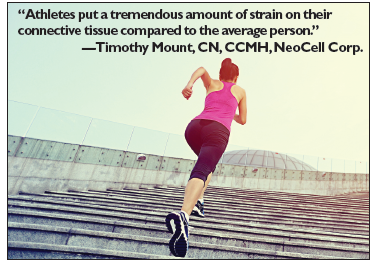 Tart cherry is an up-and-coming ingredient in the sports nutrition category. Pluta Carter believes that Montmorency tart cherry juice, in particular, may help reduce muscle pain and weakness after intense strength training and long-distance running. “While not specifically joint related, this exciting nutrient could effectively help minimize muscle soreness, speed muscle recovery, and in turn increase overall training capacity,” she states.
Tart cherry is an up-and-coming ingredient in the sports nutrition category. Pluta Carter believes that Montmorency tart cherry juice, in particular, may help reduce muscle pain and weakness after intense strength training and long-distance running. “While not specifically joint related, this exciting nutrient could effectively help minimize muscle soreness, speed muscle recovery, and in turn increase overall training capacity,” she states.
Tart cherry juice has snagged the interest of several sports nutrition researchers, says Malachy McHugh, Ph.D., director of research at Nicholas Institute of Sports Medicine and Athletic Trauma, Lenox Hill Hospital, New York, NY. “Numerous studies have shown that regular consumption of tart cherry juice accelerates recovery from exercise and has marked anti-inflammatory and antioxidant effects.”
A study of 46 osteoarthritis patients found tart cherry juice reduced pain and increased WOMAC scores (9). “The symptom relief was due to the anti-inflammatory effects of the cherry juice,” says McHugh.
Two more items that Joiner-Bey believes should be in an athlete’s recovery and maintenance toolkit are organic flaxseed oil and purified fish oil. He explains that cells use omega-3s to produce local hormones (i.e., resolvins and protectins) that control inflammation naturally. Says Joiner-Bey, “In the absence of omega-3s, the body cannot manufacture the resolvins and protectins required to control inflammation. Omega-3 deficiency is a leading cause of chronic inflammation in the general population.”
Pluta Carter also recommends omega-3s for supporting the body’s natural response to inflammatory markers created through exercise and a diet high in omega-6 fatty acids. She states, “Omega-3s are incorporated into cartilage cell membranes; they have been shown to decrease enzymes that degrade cartilage and inflammatory cytokines thus leading to less soreness, stiffness and post-exercise discomfort.”
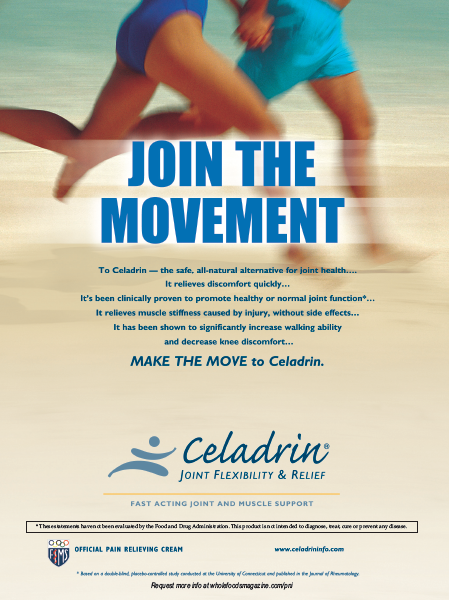 Omega-7s (as palmitoleic acid) are also helpful for joint care in athletes. Says Joiner-Bey, “Although it is not considered to be an EFA, this omega-7 has been recently concentrated from fish oil to produce a supplement that is extremely effective in reducing an important biomarker for inflammation anywhere in the body.” Specifically, palmitoleic acid may reduce C-reactive protein or CRP, “better that any other tested nutrient. This understanding is quite applicable to athletic joint inflammation.”
Omega-7s (as palmitoleic acid) are also helpful for joint care in athletes. Says Joiner-Bey, “Although it is not considered to be an EFA, this omega-7 has been recently concentrated from fish oil to produce a supplement that is extremely effective in reducing an important biomarker for inflammation anywhere in the body.” Specifically, palmitoleic acid may reduce C-reactive protein or CRP, “better that any other tested nutrient. This understanding is quite applicable to athletic joint inflammation.”
Also working on the cellular level, methylsulfonylmethane, or MSM, allows for faster recovery and joint comfort. For instance, human trials suggest it reduces exercise-induced pro-inflammatory cytokine IL-6 and boosts anti-inflammatory markers (10). “Several studies have shown how the OptiMSM brand of methylsulfonylmethane decreases the expression of inflammatory cytokines that may lead to cartilage degradation,” says Rodney Benjamin, director of R&D and technical service for Bergstrom Nutrition, Vancouver, WA.
He says that a pilot study (with data presented as a poster at the International Society of Sports Nutrition conference this past June) found that the branded MSM created a significant decrease in inflammatory IL-6 immediately following exhaustive exercise. These data build on previous research about MSM’s ability to down-regulate the expression of inflammatory cytokines from stimuli like exercise.
“An additional finding in the study showed that the MSM group had a two- to three-fold increase of the anti-inflammatory cytokine interleukin-10 (IL-10) over placebo following lipopolysaccharide (LPS) stimulation,” says Benjamin. “This suggests that MSM may not only reduce initial expression of potentially destructive inflammatory cytokines, but it may also help support the body’s ability to produce inflammatory mediators following an acute bout of exercise.”
Dan Lifton, CEO of Quality of Life Labs, Purchase, NY, feels athletes should consider both inflammation support and joint structure support: “Since joint care is not just about cartilage and is not only about short-term solutions, the best approaches are those which support the health of bone, cartilage, synovial tissue, and muscles—and offer not only post-exercise recovery but also pathways to rebuilding cartilage and improving joint-health overall.”
His firm offers several combination products in the joint health category, including one made with avocado soy unsaponifiables (ASU, as AvoVida), vitamin D3, vitamin K2 (as VitaMK7) and boron. “Not only may ASU protect existing carti lage, it can also help build new cartilage. It may also increase the synthesis of collagen and proteoglycans, which is important since these components help make up connective tissue,” says Lifton.
Another approach comes from Lou Paradise, president and chief of research, Topical BioMedics, Inc., Rhinebeck, NY, who feels minerals and trace minerals are vital for athletes, as they can become depleted from sweating and mineral deficiencies are a major contributor to joint damage. He adds, “Minerals and electrolytes are very important for pre- and post-exercise recovery.”
They may not realize it, but mineral replenishment is especially important for women. “Women are more likely to suffer the adverse effect of joint damage—especially in athletics…women are grossly underserved in getting the information they need to make good healthy choices,” he states.
Part of the problem, he believes, is that women are often bombarded with messages about which calcium to take, but not much education about all their requirements for minerals, especially for active women. He states, “When women are presented with the comprehensive, well-rounded information they need—not just who has the best calcium—they quickly become empowered and take action that lasts a lifetime and improves their lives and the lives of their families. In doing so, they consequently avoid a lifetime of pain and suffering.”
As for when to start incorporating joint health nutrients into the diet, Tim Hammond, vice president of sales and marketing for Bergstrom Nutrition, says that preventative care is key. “Healthy joints provide the athlete with a cornerstone to pursue goals where mobility and range-of-motion play an extremely important role. That’s why it’s advantageous for athletes to begin supporting joints early in a preventive manner before experiencing discomfort,” he states. “Without a proactive mindset, athletes won’t reap the benefits that joint maintenance and exercise recovery can bring.”
When Will I Feel a Difference?
After shoppers ask what to take for their joints, their next question may be, “When will I feel a difference?”
Since supplements are not drugs—offering immediate pain dulling, like NSAIDS—it’s important for shoppers to have reasonable expectations for supplements. “When it comes to natural solutions for ailments, it is very important to be patient because the mechanism of action can take a little longer, but the end result will be much better for your body,” says West.
|
Select Joint Care Products for Athletes Barlean’s Organic Oils: Barlean’s Joint Remedy (omega-7 palmitoleic acid), Barlean’s Omega Swirl Fish Oil, Barlean’s Omega Swirl Flaxseed Oil, Barlean’s Organic High-Lignan Flaxseed Oil and Barlean’s Signature Fish Oil. |
McHugh says timing matters with tart cherry. He states, “The typical soreness that athletes experience on the days after strenuous exercise will be reduced if they have consumed cherry on the days prior to the exercise, and on the days after the exercise.”
For supplements that support joint structure, the timing can be on the longer side. Glucosamine and chondroitin make take weeks for benefits to be felt.
Zhang says the quality of chondroitin also plays a role in its efficacy. Since the cost to source this ingredient has increased, it has become the subject of adulteration and sub-standard sourcing, he states, and some formulas don’t have the right amount included.
“If you suffer from degenerative knee disease, take chondroitin for a sustained period of time and still do not feel any improvement, it is likely that the supplement you take does not have adequate amount of chondroitin in it, is made of lower quality ingredients or is adulterated,” Zhang believes.
Collagen may also take patience. Says West, “Research regarding BioCell Collagen indicates people saw a 40% reduction in joint discomfort within just two months.”
Mount says retailers can tell shoppers that while collagen starts doing its job immediately, “it takes time before enough tissue is rebuilt before the athlete notices the effects.” He recommends taking collagen for one to three months for joint support, though some people may feel a difference after just a few weeks.
Likewise, Joiner-Bey says it takes time for omega-3s to be incorporated into cell membranes, where it can do its work for inflammation support. “It may take as long as three to six months for omega-3s to manifest the full range of their benefits.”
Regarding astaxanthin, Marr says, “people should feel a difference from taking BioAstin after about a month.”
Supplements that may offer a shorter timeframe include HA, which Mount says could be as fast as three to five days. “That creaky, achy feeling may be alleviated because HA is transported into the joint relatively quickly in supplement form and an athlete’s tank can be refilled after a few doses,” he states, adding “However, HA also is lost from the joint just as fast, so regular supplementation is encouraged for ongoing joint hydration.”
Meanwhile, NEM from Stratum is said to take seven to 10 days for benefits to be felt (10–12). Says Dockery, “NEM works through modulating the inflammatory process, not totally inhibiting it (13, 14).”
Rub It In
Topical joint products can also help athletes stay on their A-game. “Topical analgesic products can help in treating soreness, stiffness, strains, sprains and joint pains. They not only help relieve the pain, they can also help with loosen muscles either before or after physical activity,” says Wellington Quan, general manager of Prince of Peace, Hayward, CA. “This is important because keeping the muscles loosened can help prevent injury and also speed up recovery from the workout.”
Quan points out that sports trainers often use topical analgesics to loosen up athletes’ muscles before activity and again afterward “to help reduce muscle soreness and stiffness to help speed up workout recovery.”
Paradise says a cream from his company (Topricin) helps maximize homeostasis and optimize healing in joint, nerve and muscle tissue. “This is the beauty of resolving pain through enhanced healing,” he states. “Keeping the joints healthy sets the stage for the body to easily handle crisis/injury for faster recovery.”
He believes if the homeopathic cream (with ingredients like arnica, belladonna, echinacea and more) is used before and after physical exertion, it will support “natural detoxification at the cellular level to maximize healthy joint function while helping the body maintain healthy, oxygen-rich blood to the cells.” WF
References
1. H.L. Lopez, “Effects of BioCell Collagen on Connective Tissue Protection And Functional Recovery From Exercise In Healthy Adults: A Pilot Study,” J. Int. Soc. Sports Nutr. 11 (Suppl 1): P48 (2014).
2. Bergstrom Nutrition, www.bergstromnutrition.com/optimsm/msm-benefits-3/sports-nutrition, accessed Aug. 24, 2015.
3. J.A. Singh et al., “Chondroitin for Osteoarthritis,” Cochrane Jan. 28, 2015, www.cochrane.org/CD005614/MUSKEL_chondroitin-for-osteoarthritis, accessed Aug. 24, 2015.
4. J.K. Udani, “UC-II for Joint Support: A Randomized, Double-Blind, Placebo-Controlled Study In Healthy Volunteers,” Poster Presented At The 10th Anniversary Natural Or Placebo Daily For 120 Days. Supplements: An Evidence-Based Update,” San Diego, CA, February 1-2, 2013.
5. B. Djordjevic, et al., “Effect of Astaxanthin Supplementation on Muscle Damage and Oxidative Stress Markers in Elite Young Soccer Players,” J. Sports Med. Phys. Fitness (2012) 52.
6. I. Baralic et al., “Effect of Astaxanthin Supplementation on Salivary IgA, Oxidative Stress, and Inflammation in Young Soccer Players,” Evidence-Based Complementary and Alternative Medicine, Volume 2015 (2015), http://dx.doi.org/10.1155/2015/783761.
7. Horphag Research, www.pycnogenol.com/home/detail/new-research-pycnogenol®-naturally-reduces-osteoarthritis, accessed Aug. 24, 2015.
8. Horphag Research, www.pycnogenol.com/home/detail/study-shows-pycnogenol®-improves-fitness-and-muscle-recovery, accessed Aug. 24, 2015.
9. H.R. Schumacher, et al., “Randomized Double-Blind Crossover Study Of The Efficacy Of A Tart Cherry Juice Blend In Treatment Of Osteoarthritis (OA) Of The Knee,” Osteoarthritis and Cartilage 21 (8), 1035–1041 (2013).
10. K.J. Ruff, et al., “Eggshell Membrane: A Possible New Natural Therapeutic For Joint & Connective Tissue Disorders. Results From Two Open-Label Human Clinical Studies,” Clin. Interv. Aging 4, 235–240 (2009).
11. K.J. Ruff, et al., “Eggshell Membrane In The Treatment Of Pain And Stiffness From Osteoarthritis Of The Knee: A Randomized, Multicenter, Double Blind, Placebo Controlled Clinical study” Clin. Rheumatol. 28, 907–914 (2009).
12. U. Danesch, et al., “NEM Brand Eggshell Membrane Effective In The Treatment Of Pain Associated With Knee And Hip Ostwoarthritis: Results From A Six Center, Open Label German Clinical Study,” J. Arthritis 3(3):136(2014).
13. K.F. Benson, K.J. Ruff and G.S. Jensen, “Effects of Natural Eggshell Membrane (NEM) On Cytokine Production In Cultures Of Peripheral Blood Mononuclear Cells: Increased Suppression Of Tumor Necrosis Factor-Α Levels after in vitro Digestion,” J. Med. Food 15 (4), 360–368 (2012).
14. K.J. Ruff and D.P. DeVore, “Reduction of Pro-Inflammatory Cytokines In Rats Following 7-Day Oral Supplementation With A Proprietary Eggshell Membrane-Derived Product” Mod. Res. Inflamm. 3 (1), 19–25 (2014).
Published in WholeFoods Magazine, October 2015


